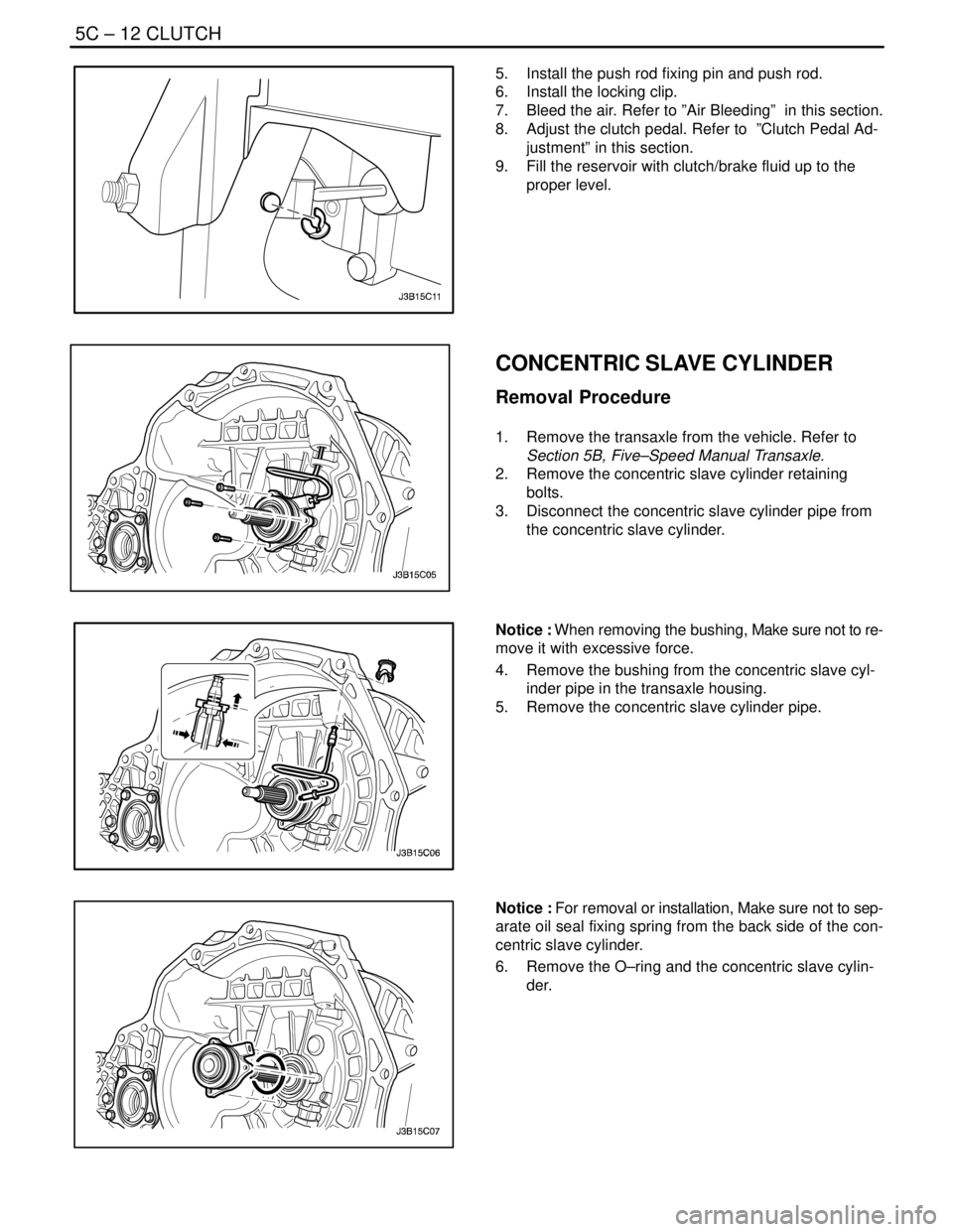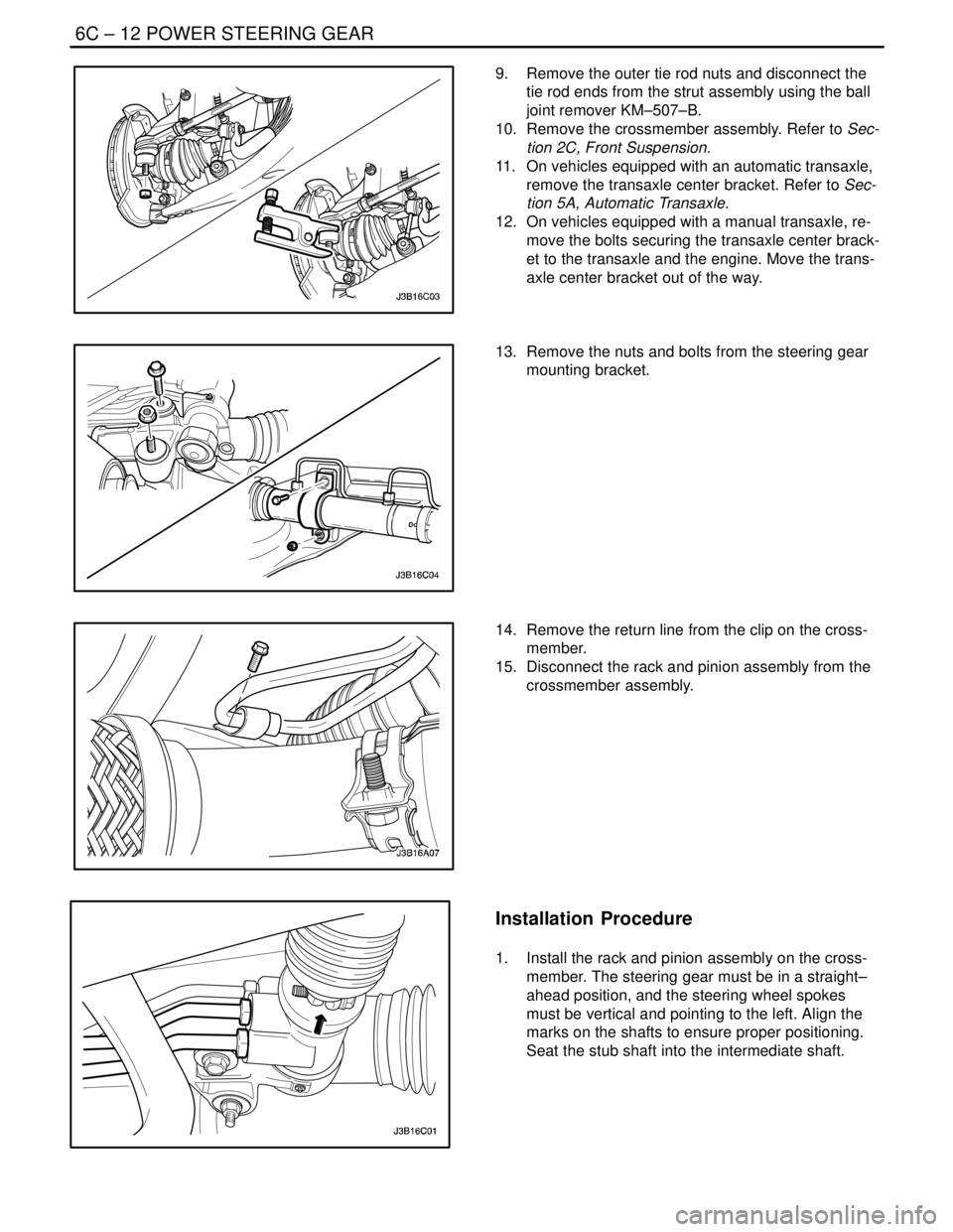Page 1897 of 2643
5C – 10ICLUTCH
DAEWOO V–121 BL4
Installation Procedure
1. Coat the spline on the clutch disc with multi–pur-
pose grease.
2. Align the pressure plate and the clutch disc onto
the flywheel using the clutch arbor J–42474.
3. Install the pressure plate bolts.
Tighten
Tighten the bolts to 15 NSm (11 lb–ft).
4. Remove the clutch arbor J–42474.
5. Install the transaxle into the vehicle. Refer to Sec-
tion 5B, Five–Speed Manual Transaxle.
6. Connect the negative battery cable.
CLUTCH MASTER CYLINDER
ASSEMBLY
Removal Procedure
Before disconnecting the reservoir tank hose, remove the
clutch/brake fluid from the reservoir tank.
1. Remove the locking clip.
2. Remove the push rod fixing pin and push rod.
3. Disconnect the hose clamp on the master cylinder.
4. Disconnect the master cylinder hose.
5. Remove the master cylinder pipe.
Page 1899 of 2643

5C – 12ICLUTCH
DAEWOO V–121 BL4
5. Install the push rod fixing pin and push rod.
6. Install the locking clip.
7. Bleed the air. Refer to ”Air Bleeding” in this section.
8. Adjust the clutch pedal. Refer to ”Clutch Pedal Ad-
justment” in this section.
9. Fill the reservoir with clutch/brake fluid up to the
proper level.
CONCENTRIC SLAVE CYLINDER
Removal Procedure
1. Remove the transaxle from the vehicle. Refer to
Section 5B, Five–Speed Manual Transaxle.
2. Remove the concentric slave cylinder retaining
bolts.
3. Disconnect the concentric slave cylinder pipe from
the concentric slave cylinder.
Notice : When removing the bushing, Make sure not to re-
move it with excessive force.
4. Remove the bushing from the concentric slave cyl-
inder pipe in the transaxle housing.
5. Remove the concentric slave cylinder pipe.
Notice : For removal or installation, Make sure not to sep-
arate oil seal fixing spring from the back side of the con-
centric slave cylinder.
6. Remove the O–ring and the concentric slave cylin-
der.
Page 1900 of 2643
CLUTCH 5C – 13
DAEWOO V–121 BL4
Installation Procedure
1. Install the concentric slave cylinder and the pipe.
2. After installing the pipe screw provisionally, tighten
the concentric slave cylinder retaining bolts.
Tighten
Tighten the concentric slave cylinder retaining bolts to
7 NSm ( 62 lb–in).
3. Tighten the pipe screw.
Tighten
Tighten the pipe screw to 15 NSm (11 lb–ft).
4. Install the bushing onto the transaxle housing.
5. Connect the pipe with bushing.
6. Install the transaxle into the vehicle. Refer to Sec-
tion 5B, Five–Speed Manual Transaxle.
Page 1903 of 2643

6A – 2IPOWER STEERING SYSTEM
DAEWOO V–121 BL4
DIAGNOSIS
POWER STEERING SYSTEM
PRESSURE TEST
Tools Required
KM–354–B Pressure Test Gauge Kit
Check the fluid pressure as follows to determine whether
the trouble is in the pump or the gear unit.
Test Procedure
1. Check the power steering fluid level and the power
steering pump belt tension. Refer to ”Checking and
Adding Fluid” in this section and Section 6B, Power
Steering Pump.
2. Disconnect the high pressure line at the pump. Use
a small container to catch any fluid.
3. Connect the hose of the pressure test gauge kit
KM–354–B to the power steering pressure hose
from the power steering pump.
4. Place the gear selector lever in PARK (automatic
transaxle–equipped vehicles) or NEUTRAL (manual
transaxle–equipped vehicles). Set the parking
brake.
5. Open the gauge valve fully.
6. Start the engine and let it idle.
7. Turn the steering wheel from lock to lock several
times to warm the fluid to operating temperature.
8. Increase the engine speed to 1,500 rpm.
Notice : The power steering pump could be damaged if
the valve is fully closed for more than 5 seconds.
9. Close the gauge valve fully, and read the pressure.
The pump pressure with the valve closed should be
between 8,330 kPa to 8,820 kPa (1,208 psi to
1,279 psi). With electronic variable orifice, the pres-
sure should be between 8,500 kPa to 8,960 kPa
(1,233 psi to 1,299 psi).
10. Immediately open the gauge valve fully.
11. Turn the steering wheel all the way to the left and
the right. If the pressure is within the specified lim-
its, the problem is not in the pump. Check the pow-
er steering gear for leaks.
POWER STEERING SYSTEM LEAK
TEST
General Procedure
Inspect the following:
S The fluid reservoir for overfill.
S Fluid for aeration and overflow.
S The hoses for loose connections.
S The torsion bar, stub shaft and adjuster seals for
leaks.
S The component sealing surfaces for damage.
Important : Verify the exact point of the leak. The point
from which the fluid is dripping is not necessarily the point
at which the system is leaking. When service is required,
clean the leak area upon disassembly, replace the leaking
seal, check the component sealing surfaces for damage
and reset the torque bolt to specifications, where required.
External Leak Check
The purpose of this procedure is to pinpoint the location of
the leak. In some cases, the leak can be easily located, but
seepage–type leaks may be harder to find. To locate seep-
age leaks, use the following method:
1. With the engine off, wipe dry the complete power
steering system.
2. Check the power steering fluid level in the pump’s
reservoir. Adjust the fluid level as necessary. Refer
to ”Checking and Adding Fluid” in this section.
Notice : Do not hold the steering wheel at a stop for any
length of time as this can damage the power steering
pump.
3. Start the engine. Turn the steering wheel counter-
clockwise and clockwise from stop to stop several
times.
4. Find the exact area of the leak and repair it.
Page 1929 of 2643

6C – 12IPOWER STEERING GEAR
DAEWOO V–121 BL4
9. Remove the outer tie rod nuts and disconnect the
tie rod ends from the strut assembly using the ball
joint remover KM–507–B.
10. Remove the crossmember assembly. Refer to Sec-
tion 2C, Front Suspension.
11. On vehicles equipped with an automatic transaxle,
remove the transaxle center bracket. Refer to Sec-
tion 5A, Automatic Transaxle.
12. On vehicles equipped with a manual transaxle, re-
move the bolts securing the transaxle center brack-
et to the transaxle and the engine. Move the trans-
axle center bracket out of the way.
13. Remove the nuts and bolts from the steering gear
mounting bracket.
14. Remove the return line from the clip on the cross-
member.
15. Disconnect the rack and pinion assembly from the
crossmember assembly.
Installation Procedure
1. Install the rack and pinion assembly on the cross-
member. The steering gear must be in a straight–
ahead position, and the steering wheel spokes
must be vertical and pointing to the left. Align the
marks on the shafts to ensure proper positioning.
Seat the stub shaft into the intermediate shaft.
Page 1930 of 2643
POWER STEERING GEAR 6C – 13
DAEWOO V–121 BL4
2. Install the bolts and nuts on the steering gear
mounting bracket.
Tighten
Tighten the steering gear mounting bracket bolts and
nuts to 60 NSm (44 lb–ft).
3. Install the return line into the clip on the crossmem-
ber.
Tighten
Tightem the return line clip bolt to 8 NSm (71 lb–in).
4. On vehicles equipped with a manual transaxle,
position the transaxle center bracket in place and
install the bolts securing the bracket to the engine
and the transaxle.
Tighten
Tighten the transaxle center bracket–to–transaxle
bolts and the transaxle center bracket–to–engine bolt
to 80 NSm (59 lb–ft).
5. On vehicles equipped with an automatic transaxle,
install the transaxle center bracket. Refer to Section
5A, Automatic Transaxle.
6. Install the crossmember. Refer to Section 2C, Front
Suspension.
7. Connect the tie rod ends to the strut assembly.
8. Install the outer tie rod nuts.
Tighten
Tighten the outer tie rod nuts to 50 NSm (37 lb–ft).
Page 2273 of 2643
LITHING SYSTEMS 9B – 47
DAEWOO V–121 BL4
BACKUP LAMPS
The backup lamps are located in the rear combination
lamps They will come on when the transaxle is shifted into
reverse. On a vehicle with an automatic transaxle, the
backup lamps are activated by the neutral safety backup
(NSBU) switch. On a vehicle with a manual transaxle, they
are activated by a reverse switch which is part of the trans-
axle.
Page 2378 of 2643

9K – 2ISQUEAKS AND RATTLES
DAEWOO V–121 BL4
Glass Knock Coming From the Rear of the Vehicle When Driving
Over Bumps
ChecksAction
Check for an out–of–adjustment hatchback latch.S Test drive the vehicle in order to verify this condition.
S Loosen the latch nuts and adjust the latch downward.
Rattle Coming From Door
Checks Action
Check the door lock solenoid.S Remove the door trim panel and check if the sole-
noid is loose.
S Tighten the solenoid bolts.
Check for rattling electrical connectors inside the door trim
panel.S Tap on the trim panel and listen for a rattle.
S Remove the trim panel and wrap foam padding
around the connectors as required.
Squeak When Operating Doors
ChecksAction
Check for a lack of lubrication of the door hinge pins.S Operate the doors and listen for squeaks.
S Lubricate the door hinge pins with light oil and coat
with lithium grease.
Squeak Coming From Console When Shifting Manual Transaxle
(Condition Occurs In Cold Weather with a Cold Engine)
Checks Action
Check the manual transaxle control lever lower boot.S Move the control lever between gears and listen for
squeaks.
S Remove the floor console and replace the lower shift
boot or apply talcum powder to the lower shift boot.
Buzz From the Left Side of Instrument Panel
ChecksAction
Check for vibration of the fuse box cover against the instru-
ment panel side trim.S Tap on the cover with a finger and listen for a buzz.
S Apply 6.35 mm (0.250 inch) by 25.4 mm (1.00 inch)
felt pads to the side trim where the cover makes con-
tact.
Squeak Coming From Instrument Cluster Trim Plate
Checks Action
Check for rubbing of the cluster trim plate on the instru-
ment panel.S Test drive the vehicle in order to verify this condition.
S Remove the instrument cluster trim plate and install
felt tape to the edges.